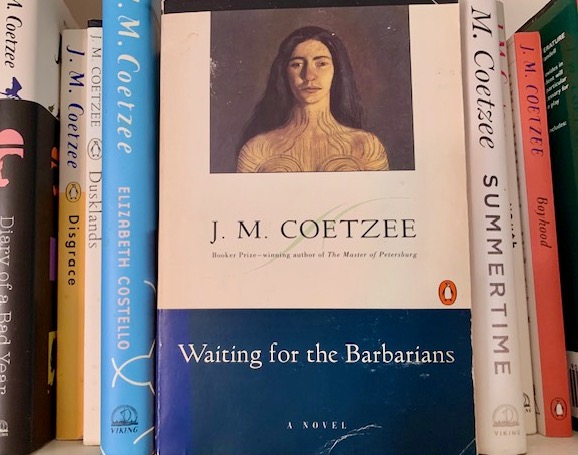J.M. Coetzee is probably less well known than he deserves to be because he deliberately avoids publicity and keeps a low profile. But he is one of the most acclaimed living writers in the English language, having won the 2003 Nobel Prize in literature after previously winning the Booker Prize twice and the CNA Literary Award (South Africa’s most prestigious award for writing in English) three times. Disgrace, one of Coetzee’s Booker Award winners, is probably his most widely read novel, but for my list of the “100 Most Lovable Novels in the English Language,” I decided to focus on one of Coetzee’s earlier novels, Waiting for the Barbarians, which comes in at #20 (alphabetically) on my list.
Waiting for the Barbarians differs somewhat from most of Coetzee’s other novels, which tend, like Disgrace, to have realistic settings and plots. Waiting for the Barbarians is much more like a fable, being set on an unnamed frontier at an unspecified time and narrated by an unnamed protagonist. But it was the first of Coetzee’s books to gain an international reputation upon its publication in 1980, winning Britain’s Geoffrey Faber Memorial Prize for fiction as well as the James Tait Black Memorial Prize for fiction from the University of Edinburgh. In the U.S., it was also nominated, curiously, for he 1982 Philip K. Dick Award for science fiction—perhaps because of its timeless, other worldly quality—although, in contrast, the Nobel Prize committee called Waiting for the Barbarians “a political thriller in the tradition of Joseph Conrad.” It’s a difficult novel to categorize or pigeonhole, which is one of its strengths. After Coetzee’s Nobel award, Penguin Books included Waiting for the Barbarians in its series of “Great Books of the 20th Century.”
Although in its form the novel is unusual for Coetzee, its focus on the theme of colonialism is not. As a native of South Africa and a descendant of Afrikaans colonizers, Coetzee often explores what colonization does to the colonizers as well as the colonized, and that certainly is the case here. The nameless setting, and the anonymous magistrate who tells the story of this remote frontier of what is simply called “The Empire,” give the novel a universal flavor: Coetzee’s 1980 parable was, at the time, a thinly-veiled protest against apartheid South Africa, and a condemnation of European imperialism in Coetzee’s native land. Read forty years later, at a moment in time when Black Lives Matter protests have sparked a worldwide awakening to the evils of the White privilege that is the legacy of centuries of colonialism, the novel still resonates.
The Magistrate, who has been at this frontier post for many years, seems to be on relatively peaceful terms with the locals, and essentially enjoys his position among them as a representative of the force that has colonized them. Into this comfortable setting barges Colonel Joll (whose name, ironically, is Afrikaans slang for “having fun”). Little more than a one dimensional villain (which is I suppose admissible in a fable), Joll is essentially the personification of imperialism. He has come to ferret out a rumored rebellion among the indigenous peoples, and by god he’s going to find it. And his methods of interrogation are simple and brutal. As he explains to the Magistrate: “First lies. Then pressure. Then more lies, then more pressure. Then more lies, more pressure, and then comes the break. After the break, more pressure. And then at last, the truth.” The Magistrate protests impotently. “Pressure” is of course the euphemism for “torture,” euphemism being the language of choice for imperial powers, so that, for example, “mass murder of millions” becomes “final solution.” And in case the Magistrate’s benevolent administration had lulled us into a false sense of peace, Joll’s tactics underscore the basic truth of colonialism: Pious platitudes to the contrary, it’s not about “civilizing” or “sharing,” it’s about power, and its concomitant exploitation. Period. And by the time Joll is done with his interrogations, he has fomented the rebellion he is looking for.
The Magistrate is a far more complex character. Once Joll has finished his inquisition and is on his way back to the capital, the Magistrate adopts one of Joll’s victims—a young woman whose feet have been broken and her eyes half blinded during her own interrogation. Attracted to this woman, he brings her to live in his apartments in the fortress, sparking a good deal of gossip around the outpost. When, feeling tender toward her, he asks whether she wants to stay with him, and when she insists she wants to go back to her family, takes her into the mountains on a dangerous mission to return her to her own people. But despite his opposition to the worst abuses of the colonial empire, he is still a representative of that government. He has enjoyed his own comfortable life for decades as a part of that system. And if Joll is a personification of the empire, the Girl seems a personification of the indigenous population, whom the Magistrate wants to love him but who only want to be out of his hands. His rule may be benevolent, but it is a benevolent dictatorship, and would not exist without the threat of Joll and his ilk behind it.
Coetzee took the title of the novel from the Greek poet Constantine Cavafy’s 1904 poem of the same name. The poem presents a city whose people are all awaiting the arrival of a feared army of “barbarians,” who ultimately fail to arrive. In the end, the poem asks “What is to become of us without Barbarians? Those people were a solution of a sort.” I won’t talk about how the book ends to avoid spoiler activity, but suffice it to say that by the time the end comes, we are pretty certain who the barbarians actually are. As Walt Kelly’s Pogo famously said, “We have met the enemy, and he is us.”

